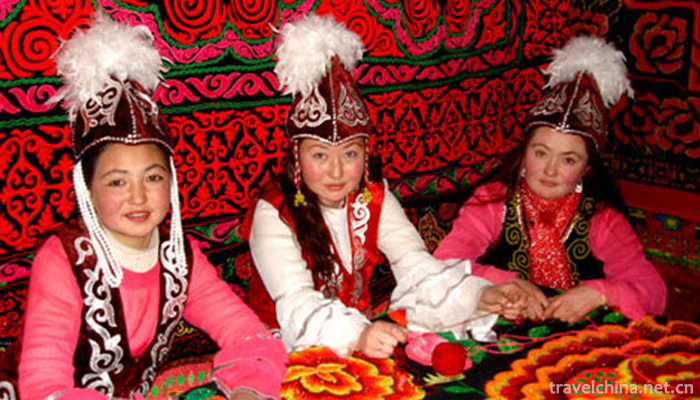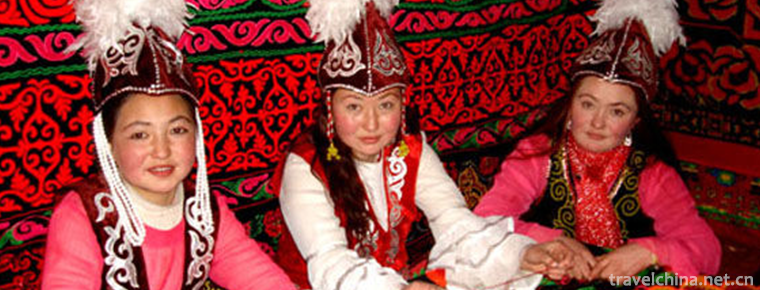Kirgiz embroidery

Kirgiz embroidery
Kirgiz embroidery is a traditional embroidery in Wensu County, Xinjiang Uygur Autonomous Region, China. Kirgiz women are good at embroidery. They embroider various delicate patterns on headscarves, pillows, quilts, sleeves, horsewear and hanging cloth decorations, including flowers, birds, animals and various geometric patterns. Bright colors and vivid images.
In 2008, Kirgiz embroidery declared by Wensu County of Xinjiang Uygur Autonomous Region was listed in the second batch of national intangible cultural heritage list with the approval of the State Council.
historical origin
Kirgiz embroidery has a long history and is closely related to the Central Plains culture. In the tombs of the Western Han Dynasty excavated in the Yenisai River Basin, woolen fabrics with exquisite patterns of birds, animals and plants were unearthed. It is recorded that there are craftsmen specializing in weaving silk brocade in Kirgiz area of Yenisai River Basin. "History of the Yuan Dynasty, Shizubenji" records that in 1286 (to the twenty-third year of the Yuan Dynasty), the Yuan government "owed State Bureaus 56,139 pieces of craftsmen's yarn to blossom 132". For thousands of years, the tall Pamirs have never lost contact with the mainland of their motherland.
artistic characteristics
style
They weave tapestries and carpets with exquisite patterns. Flower felt, white felt hat, silver saddle, wooden bowl, box, etc., exquisite and beautiful, simple and durable. Red, blue and white are the main crafts, especially red is the most popular.
Kirgiz men's traditional clothing is white embroidered collar shirt, coat collarless long shirt "loops", cuffs with black cloth edge. The style of jacket is vertical collar and button collar. Belts are tied over the coat. Wear wide-legged pants, suitable for nomadic riding, women's clothing for the broad collarless, less than knee length, inlaid with silver buttons on the jacket. A pleated skirt with fur at the bottom or a pleated dress of various colors at the bottom. A shoulder made of leather or cloth. Kirgiz women are good at embroidery. They often embroider beautiful and delicate geometric patterns on the collar, sleeves and chest of clothes. The main colours are red, blue and white. Knitting also shows exquisite skills. Tapestries and carpets woven with dyed wool and camel hair, curtains and aprons woven with Achnatherum splendens and red willow branches are well known in the world.
pattern
Among the Kirgiz embroidery patterns, the mountain peaks have become an indispensable landscape. The mountains in the eyes of the Ko people are mostly snow-capped icebergs, holy and pure white. Under their hands, the peaks are embroidered into white, pure white triangles, which fluctuate along the collar, trousers feet, sleeves, or the top of the blankets and the edge pillows of the walls. Sometimes, triangles are black or red-green, black represents Tushan, red and green represents Hongshan and Qingshan.
Inheritance significance
This embroidery is of great significance in inheritance. It has bright colors, beautiful shapes and is generous and simple. They mostly adopt flower and plant, birds and animals, sun, moon and stars and other patterns and geometric figures, the color is mainly black, white, red, blue, green and other basic tones. Different colors mean different meanings: black means deep and broad, indomitable and simple; blue is regarded as sacred and noble color with the sky; red means joy, warmth and happiness; green symbolizes spring and vitality. Kirghiz people are fond of white, because white can cause the moon, flour, cotton, milk and other beautiful things of rich association, but also pure, sincere implications. Every color in nature has been endowed with profound implications by Kirgiz.

-
1.Beihai Seabed World
Beihai Seabed World is a national AAAA-level tourist attraction and national marine science education base. It is a large-scale comprehensive ocean hall which mainly displays marine organisms and inte
Time 2018-12-26 -
2.Shuipo Liangshan Scenic Area
Shuipo Liangshan Scenic Area is located in Liangshan County, Jining City, Shandong Province, with an area of 4.6 square kilometers. It was named for the Liangshan Uprising in Shuihuzhuan, one of the f
Time 2019-02-08 -
3.Winter capture of Chagan Lake
Winter fishing in Chagan Lake, namely ice and snow fishing (or hunting) in Chagan Lake in winter, is a traditional fishery production mode (custom) in Qianguoerros Mongolian Autonomous County
Time 2019-04-15 -
4.Gengcun Folk Stories
Gengcun Folklore Gengcun Folklore, the traditional folk literature of Gaocheng City, Hebei Province, is one of the intangible cultural heritage at the national level.
Time 2019-05-01 -
5.Mira Gahei Mile La Ga Hei
Mira Gahei, Dongxiang folk tale. Also known as "Moonlight Mirror". Among the Dongxiang people, there are also poem-style stories of "Mira'er Hei", which are intermingled in rhyme a
Time 2019-06-04 -
6.Performing and Making Skills of Qiang Flute
Qiang flute is an ancient single-reed gas singing instrument in China. It has a history of more than 2000 years. It is popular in the Qiang people's residence of Aba Tibetan Autonomous
Time 2019-06-10 -
7.The riddle of Qinglin Temple
The number of riddles in Qinglin Temple is abundant, there are about 5000. There are many kinds of riddles, such as object riddles, event riddles and crossword riddles. Many of the riddles have high c
Time 2019-06-11 -
8.suzhou pingtan
Suzhou Pingtan is the general name of Suzhou Pingtan and Suzhou Pingtan Ci. It is a traditional form of opera and opera that uses Wu dialect to speak and perform freely. It came into being and became
Time 2019-06-17 -
9.virtuous and filial
Xianxiao was born out of Buddhist folklore, and has a deep relationship with Xiliangle music, Dunhuang Bianwen and Hexi Baojuan. The way of inheritance mainly depends on the artistic population. Its c
Time 2019-07-01 -
10.Legend of Zhaos Orphans
Zhao's orphan legend is one of the folk legends in Shanxi Province. In the folk of Yuxian County, the legends about Zhao's orphans are handed down orally and orderly. Every year, there are more than 1
Time 2019-07-25 -
11.Stir fried pork with salted vegetables
Stewed pork with dried plum is a famous traditional flavor dish in Shaoxing, Zhejiang Province. The main raw materials are dried plum and streaky pork. Dried vegetables absorb meat fat to remove astri
Time 2020-03-18 -
12.Qingyang Palace
Qingyang palace is located in the second section of the first ring road in Chengdu, Sichuan Province. It is known as "the first Taoist temple in Western Sichuan" and "the first jungle in Southwest China". It is also one of the famous Taoist temples in China.
Time 2020-11-05